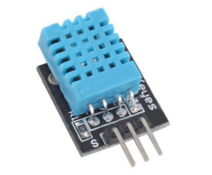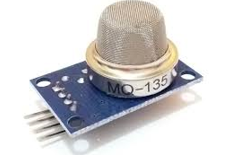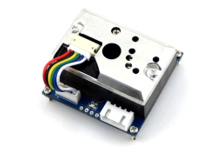AIR QUALITY MONITORING SYSTEM BASED ON IOT USING RASPBERRY PI
Abstract
Air pollution is the largest environmental and public health challenge in the Today’s world which leads to adverse effects on Human health, climate and ecosystem. Air gets polluted due to emission of poisonous gas from vehicle and industries which have become a menace to the living beings. Due to this menace both indoor and outdoor air quality monitoring in real time has become mandatory. This can be successfully achieved using Internet of Things which plays a vital role in our air quality monitoring system. IOT converging with cloud computing offers a novel technique for better management of data coming from different sensors, collected and transmitted by ARM based minicomputer Raspberry pi. It incorporates a MQ Series sensor interfaced to a raspberry Pi to send the sensor perusing to a cloud. This prototype can be easily adapted to any monitoring systems with minor changes and can be made scalable for tomorrow
PROPOSED SYSTEM
The Proposed model detects the harmful toxic gases and shows the real time monitoring of the concentration of the gases in the industrial floor. This concept uses gas sensors like the DHT11 (temperature and humidity) sensor. The idea can be realized by introducing Raspberry-pi and IoT shield. The idea of this case study is to sense the level of various gases in the industrial floor and upload these data to the cloud, further providing a warning alarm if the level of gases exceeds certain threshold limit. With IoT Shield, device manufacturers, system integrators and IoT network operators can rapidly secure and manage devices, with no need for any security expertise, no costly development and testing resources and no change to the application code or device functionality. The API (application program interface) can be enabled which works as a medium between the Raspberry-Pi and the server. It also provides the permission to the sensor to write the readings on the cloud web server by sharing to email id. performance and long life, Simple drive circuit. Resistance values of these sensors differ with various concentrations of gases. So, when using this component, sensitivity adjustment is very necessary.
BLOCK DIAGRAM
The Proposed model of the system is as follows. Figure shows how the whole system will work. The block diagram of the system is showing that for a particular area selected how will it work. The device will be set up to take the environmental data and there will be a base standard value. The device will collect data and based on the set values it will show the output.

The system is controlled using Raspberry Pi 3b+ which is interfaced with gas sensors like MQ135, MQ7, MQ4 and also the Dust particle sensor. The DHT11 sensor updates the Temperature and Humidity values on real time basis. The complete monitored values from the sensors are updated on the cloud i.e., Smart Core. The entire data is stored in the cloud and the values will be updated on real time basis. The data updating and the flow its works is as shown in the below flow diagram

The entire system is integrated to the server i.e., cloud through API keys as shown in the below figure. Each project which is setup will have a unique APIkey which will be fed into the code through which the hardware and the cloud communicates. The complete values of the monitored air will be updated in the server and will be displayed as shown in the figure below. These data can be utilized by the user anytime and wherever required.
HARDWARE Components Used
Raspberry Pi 3b+
The Raspberry Pi 3 Model B+ is the latest product in the Raspberry Pi 3 range, boasting a 64-bit quad core processor running at 1.4GHz, dual-band 2.4GHz and 5GHz wireless LAN, Bluetooth 4.2/BLE, faster Ethernet, and PoE capability via a separate PoE HAT The dual-band wireless LAN comes with modular compliance certification, allowing the board to be designed into end products with significantly reduced wireless LAN compliance testing, improving both cost and time to market. The Raspberry Pi 3 Model B+ maintains the same mechanical footprint as both the Raspberry Pi 2 Model B and the Raspberry Pi 3 Model B.
Specifications
Processor: Broadcom BCM2837B0, Cortex-A53 64-bit SoC @ 1.4GHz
Memory: 1GB LPDDR2 SDRAM
Connectivity:
- 4GHz and 5GHz IEEE 802.11.b/g/n/ac wireless LAN, Bluetooth 4.2, BLE
- Gigabit Ethernet over USB 2.0 (maximum throughput 300Mbps)
- 4 × USB 2.0 portsSpecifications

DHT11
DHT11 Specifications:
- Operating Voltage: 3.5V to 5.5V
- Operating current: 0.3mA (measuring) 60uA (standby)
- Output: Serial data
- Temperature Range: 0°C to 50°C
- Humidity Range: 20% to 90%
- Resolution: Temperature and Humidity both are 16-bit
- Accuracy: ±1°C and ±1%

MQ135 Air quality Sensor
Features:
- High Sensitivity
- High sensitivity to Ammonia, Sulfide and Benze
- Stable and Long Life
- Detection Range: 10 – 300 ppm NH3, 10 – 1000 ppm Benzene, 10 – 300 Alcohol
- Heater Voltage: 5.0V
- Dimensions: 18mm Diameter, 17mm High excluding pins, Pins – 6mm High
- Long life and low cost

DUST SENSOR
Dust Sensor is a simple air monitoring module with onboard Sharp GP2Y1010AU0F. It is capable of detecting fine particle larger than 0.8μm in diameter, even like the cigarette smoke. Analog voltage output of the sensor is linear with dust density. The module has embedded voltage boost circuit to support wide range of power supply.

IoT
The Internet of things (IoT) is a system of interrelated computing devices, mechanical and digital machines, objects, animals or people that are provided with unique identifiers (UIDs) and the ability to transfer data over a network without requiring human-to-human or human-to-computer interaction.
The definition of the Internet of things has evolved due to the convergence of multiple technologies, real-time analytics, machine learning, commodity sensors, and embedded systems. Traditional fields of embedded systems, wireless sensor networks, control systems, automation (including home and building automation), and others all contribute to enabling the Internet of things. In the consumer market, IoT technology is most synonymous with products pertaining to the concept of the “smart home”, covering devices and appliances (such as lighting fixtures, thermostats, home security systems and cameras, and other home appliances) that support one or more common ecosystems, and can be controlled via devices associated with that ecosystem, such as smartphones and smart speakers.

Conclusion
These thesis represents a smart way to monitor environment and air as well as sound pollution, available at low cost with multiple sensors embedded on to the single board computer i,e Rapsberry Pi . In the proposed architecture functions of different sensors and their working procedure were discussed. How they work, their functionality, their optimal uses and their data taking procedures are also discussed here.
Future Scope
Our work can demonstrate vast opportunities to work on the device, on the multiple apps and also on the field using hardware components . The device can be used any time efficiently in different locations of a city. The device can be updated with additional sensors that can sense data from the existence of other gases such as O2 and H2
Address List
- # 28, 1st Main Road,1st Cross, Shakthi Garden, Kalyan Nagara, Bengaluru-72
- +91-968-696-3065
- eng@pincore.in
